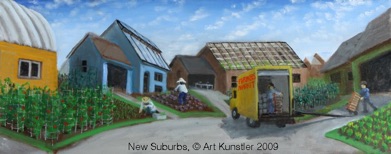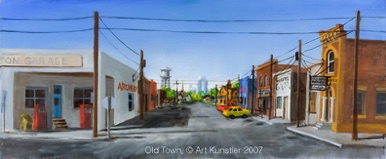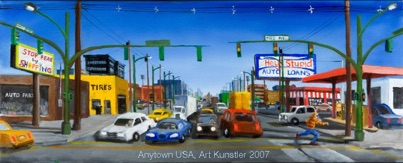THE evolution OF TOWNS














































ANY SMALL TOWN
Until the early 1900's the major mode of transportation was the horse. Throughout the midwest vestiges of small towns remain on a 10 mile grid, because you could take a horse and wagon 5 miles into town, shop and get home in a day. Wide streets let you turn your house and wagon around. Now, the rural population is reduced by three quarters, and the remaining people drive up to 60 miles to shop.
ANY TOWN
This scene can be found in any city in America. This is the world based on the automobile. As the small towns died, one town in about a 60 mile radius became the commercial center. With a car you can easily drive 30 miles and back to shop. The dominate features are stip malls, drive-throughs, and parking lots. Notice that the
pedestrians are left out of the plan and have to run for their lives.
NEW TOWN
Ironically New Town is in many ways like older cities. Before the auto hijacked the built environment, centuries of evolution developed the town based on the human. The major mode of transportation was walking. There is a dense enough population in urban centers to support public transportation and neighborhood shops and markets.
THE NEW SUBURBS
Suburbs based on cars will eventually become untenable. The spilt level ranch houses will be converted to green houses, the yards planted in gardens. and the cull de sacks will be used to load up vegetables bound for the farmers market like the one in the painting " New Town"
FUTURE TOWN
The architect Paulo Soleri, designed structures that could house an entire city. These buildings would take up a fraction of the area of a modern city. The residential spaces and parkways would be on the outside of the building, then inside, shopping, schools, offices and in the middle, storage, transportation and industry. Parks and gardenswould be just outside the doors.Here is ArtKunstler’s idea for a structure that could hold about 4,000 people.
